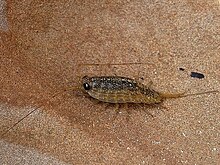Ligia exotica, also called sea roach[2] or wharf roach,[3] is a woodlouse-like isopod, a sea slater in the family Ligiidae. It is found in various parts of the world living on rocky coasts and harbour walls just above high water mark.
| Ligia exotica | |
|---|---|

| |
| Scientific classification | |
| Domain: | Eukaryota |
| Kingdom: | Animalia |
| Phylum: | Arthropoda |
| Class: | Malacostraca |
| Order: | Isopoda |
| Suborder: | Oniscidea |
| Family: | Ligiidae |
| Genus: | Ligia |
| Species: | L. exotica
|
| Binomial name | |
| Ligia exotica Roux, 1828[1]
| |
Description
editLigia exotica can grow to 4 centimetres (1.6 inches) in length, with the males being rather bigger than the females. The general colour is dark grey, sometimes with brown flecks, and the appendages are pale brown. The head has a pair of long antennae which exceed the length of the body, and two unstalked, bulging eyes. The body is flattened dorsally and has seven thoracic segments, each with a pair of legs, and six abdominal segments. The first five of these bear flat, membranous gills and the sixth bears a pair of long, forked uropods.[3][4]
Distribution and habitat
editLigia exotica is believed to be native to the coasts of Western Europe and the Mediterranean Sea. Other authorities suggest it originated in the Pacific and Indian Oceans.[5] The fact that Roux gave it the specific name "exotica" when he first described the species in 1828 from near Marseilles, may indicate that it was not previously known in that locality. It has spread to many other temperate and subtropical parts of the world including the Red Sea, the eastern seaboard of the United States and Hawaii. It is thought that the spread occurred unintentionally via shipping,[6] either in ballast or between the planks of timber ships.[3] Its natural habitat is rocks and cliffs in the splash zone just above high water mark where it lives in damp crevices. It is also found, sometimes in large numbers, on jetties and harbour walls.[3]
Biology
editLigia exotica is both a grazer on microalgae and diatoms[3] and a scavenger on plant remains and detritus.[6] In the eastern United States, where it is considered to be invasive, it seems to be the dominant invertebrate in its habitat. The impact of this on competing organisms and its contribution to the diet of predators has not been properly evaluated, however the NEMESIS database suggests it is not likely to be of much significance.[7]
Individual Ligia exotica are either male or female. Fertilization is internal and eggs are laid in batches of about eighty in moist cracks and fissures. Females often carry their eggs around with them using specially adapted appendages. The larvae develop into juveniles which go through a number of moults before becoming adult.[3]
Ligia exotica has a passive water transportation system through open capillaries in its legs.[8]
References
edit- ^ Marilyn Schotte (2011). Schotte M, Boyko CB, Bruce NL, Poore GC, Taiti S, Wilson GD (eds.). "Ligia exotica". World Marine, Freshwater and Terrestrial Isopod Crustaceans database. World Register of Marine Species. Retrieved January 22, 2012.
- ^ Roger Tory Peterson; Kenneth L. Gosner (1999). A Field Guide to the Atlantic Seashore: From the Bay of Fundy to Cape Hatteras. Houghton Mifflin Harcourt. p. 224. ISBN 978-0-618-00209-2.
- ^ a b c d e f Ligia exotica: Wharf roach Smithsonian Marine Station. Retrieved December 3, 2011.
- ^ Biology of Isopods[permanent dead link] Retrieved December 3, 2011.
- ^ M. L. Roman (1977). "Les oniscoides halophiles de Madagascar (Isopoda, Oniscoidea)". Beaufortia. 26 (334): 107–151.
- ^ a b "Ligia exotica Roux, 1828". Introduced Marine Species of Hawaii. Retrieved December 3, 2011.
- ^ National Exotic Marine and Estuarine Species Information System Retrieved December 3, 2011.
- ^ Ishii D, Horiguchi H, Hirai Y, Yabu H, Matsuo Y, Ijiro K, Tsujii K, Shimozawa T, Hariyama T, Shimomura M (October 23, 2013). "Water transport mechanism through open capillaries analyzed by direct surface modifications on biological surfaces". Scientific Reports. 3: 3024. Bibcode:2013NatSR...3.3024I. doi:10.1038/srep03024. PMC 3805968. PMID 24149467.
External links
edit- Data related to Ligia exotica at Wikispecies